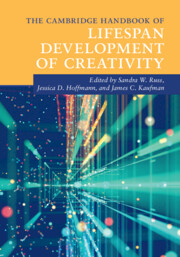Book contents
- The Cambridge Handbook of Lifespan Development of Creativity
- The Cambridge Handbook of Lifespan Development of Creativity
- Copyright page
- Dedication
- Contents
- Figures
- Tables
- Contributors
- Acknowledgments
- Introduction
- Part I Core Concepts of Lifespan Creativity Development
- Part II The Development of Creativity
- Part III Modes of Enhancement
- Part IV Environments and Contexts
- 18 Creative Identity Development in Classrooms
- 19 Creativity in Children’s Museums
- 20 Makers and Makerspaces
- 21 Organizations and Creativity
- 22 Creativity Development and Culture
- Part V Special Populations
- Index
- References
19 - Creativity in Children’s Museums
from Part IV - Environments and Contexts
Published online by Cambridge University Press: 19 November 2021
- The Cambridge Handbook of Lifespan Development of Creativity
- The Cambridge Handbook of Lifespan Development of Creativity
- Copyright page
- Dedication
- Contents
- Figures
- Tables
- Contributors
- Acknowledgments
- Introduction
- Part I Core Concepts of Lifespan Creativity Development
- Part II The Development of Creativity
- Part III Modes of Enhancement
- Part IV Environments and Contexts
- 18 Creative Identity Development in Classrooms
- 19 Creativity in Children’s Museums
- 20 Makers and Makerspaces
- 21 Organizations and Creativity
- 22 Creativity Development and Culture
- Part V Special Populations
- Index
- References
Summary
Children’s museums attract millions of families every year, providing opportunities for learning through play and for developing children’s creativity. Many of these museums actively collaborate with local communities, educators, and researchers to help improve the experiences of visitors. What makes such informal learning environments unique is how the facilitators, and the exhibits themselves, are mostly designed to provide children with an experience of guided discovery. Children actively engage with the exhibits by tinkering with materials and testing hypotheses about what will happen next, and develop creativity by interpreting novel experiences and solving discovered problems. Some museums go so far as to develop curricula and programs that explicitly promote the creativity of children. Collaborations with academic researchers influence approaches to encouraging creativity, while also evaluating the impacts of museum exhibits and programs.
- Type
- Chapter
- Information
- The Cambridge Handbook of Lifespan Development of Creativity , pp. 415 - 441Publisher: Cambridge University PressPrint publication year: 2021



